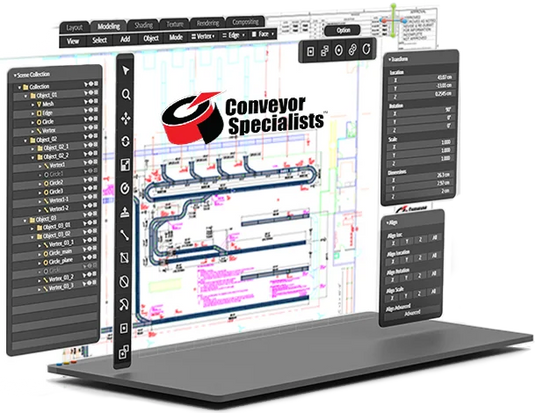Powered belt conveyors provide reliable transportation for a wide range of materials, ensuring smooth and precise movement in manufacturing, distribution, and fulfillment operations. Designed for versatility, these conveyors handle everything from lightweight packages to medium-duty loads with precision and consistency – making them ideal for machine integrations and precise product gapping. By supporting the entire base of the product along with the grip from the belt, these conveyors also easily handle inclines or declines in facilities. Whether used for simple transportation or integrated into automated systems for sorting or packaging, powered belt conveyors optimize workflow, reduce manual labor for safer working environments, and enhance productivity.
Quickly designed for your materials, flow, & budget.
Commonly Asked Questions
Why choose a Powered Belt Conveyor over a Powered Roller Conveyor?
Why choose a Powered Belt Conveyor over a Powered Roller Conveyor?
While both powered belt and roller conveyors automate material handling, powered belt conveyors are preferred in certain applications due to their unique advantages:
✅ Better for Small, Irregular, or Soft-Sided Items – Belt conveyors provide a continuous surface, making them ideal for transporting small, loose, or irregularly shaped items that might not move smoothly on rollers.
✅ Superior for Inclines and Declines – Belt conveyors offer better grip and control for moving materials up or down slopes, reducing the risk of items slipping or rolling back.
✅ Consistent Motion Without Gaps – Unlike roller conveyors, belt conveyors provide uninterrupted movement, ensuring smooth transport for fragile or unstable loads.
✅ More Versatile for Various Load Types – Ideal for lightweight, soft-bottomed, or non-rigid items such as envelopes, bags, and loose materials that wouldn't roll easily on powered rollers.
✅ Reduced Risk of Product Damage – The continuous belt minimizes jostling, making it a better choice for delicate or high-value products.
✅ Effective for High-Speed Transport – Belt conveyors maintain consistent speeds across the entire surface, offering controlled, high-speed movement when needed.
When to choose powered rollers instead?
When to choose powered rollers instead?
Powered roller conveyors are generally better for handling rigid, uniform loads like cartons, totes, pallets, and drums, especially when accumulation, sorting, or zoning is required.
What belted conveyor construction is best for me?
What belted conveyor construction is best for me?
Powered belt conveyors are designed with various constructions to suit different applications, environments, and load requirements.
1. Slider Bed Belt Conveyors
Description: Features a belt that slides over a flat steel or plastic surface (slider bed).
✔️ Best For: Lightweight to medium-duty loads, small packages, and irregular items.
✔️ Common Uses: Order fulfillment, package handling, and sorting applications.
2. Belt-Over Rollers Conveyors
Description: Uses rollers beneath the belt to reduce friction and support heavier loads.
✔️ Best For: Medium to heavy loads that require longer transport distances.
✔️ Common Uses: Warehouses, distribution centers, and bulk material transport.
3. Incline/Decline Belt Conveyors
Description: Utilizes one of the above construction types and designed for moving products up or down between levels with cleated or textured belts for product grip.
✔️ Best For: Applications needing elevation changes, such as reaching mezzanines or top of hoppers/equipment.
✔️ Common Uses: Multi-level warehouses, manufacturing facilities, food and beverage processing, and bulk materials handling such as recycling centers.
What types of belts are available?
What types of belts are available?
The type of belt used in a powered belt conveyor depends on the material being transported, the environment, and specific operational needs. Here are the most common types:
1. General-Purpose Rubber Belts
Material: Synthetic rubber (e.g., Nitrile, Neoprene)
✔️ Best For: Standard applications handling boxes, cartons, and general materials.
✔️ Common Uses: Warehouses, manufacturing, and distribution centers.
2. PVC (Polyvinyl Chloride) Belts
Material: PVC with fabric reinforcement
✔️ Best For: Light to medium-duty applications, resistant to moisture and chemicals.
✔️ Common Uses: Food packaging, pharmaceuticals, and logistics.
3. PU (Polyurethane) Belts
Material: Thermoplastic polyurethane
✔️ Best For: Food-grade applications due to non-toxic, non-stick properties.
✔️ Common Uses: Food processing, bakery, meat, and dairy industries.
4. Modular Plastic Belts
Material: Interlocking plastic segments (polypropylene, polyethylene, acetal)
✔️ Best For: High-hygiene applications, curved conveyors, and washdown environments.
✔️ Common Uses: Beverage bottling, pharmaceuticals, and frozen food handling.
5. Cleated Belts
Material: Rubber, PVC, or PU with cleats or ridges
✔️ Best For: Preventing product rollback on inclines and declines.
✔️ Common Uses: Agriculture, mining, and incline material transport.
6. High-Temperature Resistant Belts
Material: Silicone, PTFE (Teflon), steel, or heat-resistant rubber
✔️ Best For: Applications exposed to high heat or extreme temperature fluctuations.
✔️ Common Uses: Baking, drying ovens, and industrial processing.
7. Oil-Resistant Belts
Material: Steel or special rubber compounds resistant to oil and grease
✔️ Best For: Handling oily or greasy materials without belt degradation.
✔️ Common Uses: Automotive, recycling, and industrial applications.
8. Flame-Retardant Belts
Material: Fire-resistant rubber, steel, or synthetic compounds
✔️ Best For: Applications where fire hazards exist.
✔️ Common Uses: Mining, underground conveyor systems, and power plants.
9. Anti-Static Belts
Material: Carbon-coated or conductive belts
✔️ Best For: Preventing static electricity buildup in sensitive environments.
✔️ Common Uses: Electronics manufacturing and explosive environments.
10. Magnetic Belts
Material: Rubber or PVC with embedded magnetic strips
✔️ Best For: Holding and moving ferrous materials securely.
✔️ Common Uses: Metal fabrication, scrap removal, and automotive stamping.
Would you like recommendations on the best belt for your specific application? Contact us now.
Powered belt overview:
Maximize your ROI
Customize for best results
From size, materials, roller positions/spacing, accessories, and supports – let us ensure you have the right conveyor equipment specified to stretch your budget and ensure long-term operational success.
Applications and media:

Let us design a lasting solution for you
From simple to complex projects, it's important that the design and conveyor options best support your materials and flow. Let our team of experts quickly create the optimal solution for you. After a few quick questions, you will be on to a better operating future.
60+ Years Experience
enhancing the flow and safety of each customer.












